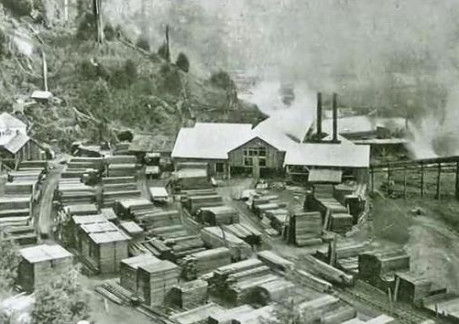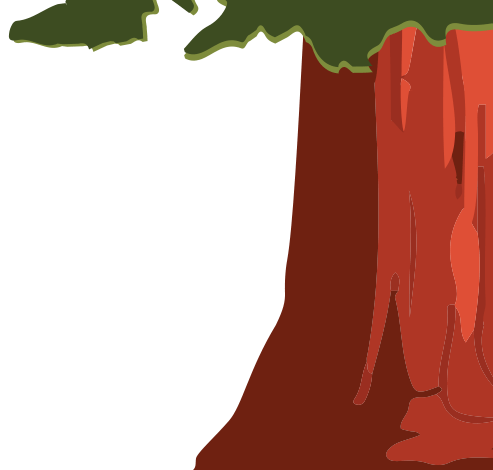Falk Historic Logging Ghost Town
- Address: Elk River Rd and Headwaters Forest Trail, Bureau of Land Management
- South Bay, CA 95503
- Phone: (707) 825-2300
- Visit Website
Unearth the mysteries of the historic logging ghost town
Dozens of tiny communities on the Redwood Coast began as lumber camps, primitive outposts in the deep forest where many men—and a few women—worked to harvest and mill the huge virgin redwood trees into lumber. Over the years, some of these grew into respectable towns with schools, churches and post offices. But this was no guarantee of permanence. The town of Falk was once home to 400 souls, employees of the Elk River Lumber Company and their families, but today virtually nothing remains of this thriving community.
Founded as a company mill town in 1884, Falk grew to 400 residents and thrived for 50 years. The town was founded by Noah Falk, one of the thousands who immigrated to California from the eastern United States, seeking a quick fortune in the gold fields. Falk left Ohio and arrived in San Francisco in 1854, but unlike the gold miners, he was lured to the “redwood gold” of the North Coast, where he worked 30 years in the lumber mills.
Taking advantage of the Timber and Stone Act, Noah Falk bought 160 acre parcels for $2.50 an acre. In 1884 he built his own lumber mill –the Falk mill- and an entire town to support its workers in this isolated site.
Because Falk was over an hour by stagecoach to Eureka, commuting was not an option; therefore the town was built to be self-sufficient. Hence, the company town had a cookhouse, post office, several houses, a general store, and a dance hall. Life in Falk was hard. The men toiled 12 hours a day, six days a week turning out milled lumber. It was shipped on the Bucksport and Elk River railroad to the town of Bucksport, located where the Bayshore mall in Eureka is today. The women often tended large gardens and livestock. The townsfolk took a break from their labor on Saturday nights, when an orchestra from eureka often entertained at the Falk dance hall.
In 1937, due to the great depression, the mill had to shut the doors to its once thriving business. A dozen residents remained into the 1940s but by the 1950s, Falk became a ghost town. Bottle hunters sifting through the town's remains and people living in the abandoned buildings became a liability concern for the Sierra Pacific Lumber Co., which owned the town site. To resolve the problem, the company razed the buildings in 1979. Aside from the rose bushes and English Ivy, the town of Falk has literally disappeared, though many of the stories remain. Visit Falk and search for the faint trace of foundations and gardens run rampant…as the tenacious redwood forest reclaims its dominion.
March 1, 1999 the federal government purchased the Headwaters Forest Reserve. Bureau of Land Management was designated the manager. The significant town of Falk was included in the 7,400 acres and plans to educate the public with self guided tours and occasional guided tours have been successful.
The self-guided tour starts about 50 yards down the trail and is a two-mile round trip that takes approximately an hour. We ask that you respect the natural and cultural resources by leaving them undisturbed. The historical significance of this area is priceless. The entire northern trail is an 11-mile round trip hike. Visitors must bring plenty of water and wear good hiking boots. The first three miles of the trail are relatively level and of moderate difficulty, while the last 2.5 miles are arduous, with steep grades exceeding 20 percent. Plants are characteristic of riparian habitat-willows, maple, alder, ferns and nettle. Access by guided hikes to the southern part of the reserve is available may 15 through November 15, with wet weather restrictions. Call the Arcata field office for reservations.
The tour starts in front of an historic orchard. The trees are predominantly cherry and plum. When the mill shut down each winter, Falk residents had to be self-sufficient. They planted orchards and gardens, and preserved their harvests to sustain them through the winter. The land along the trail had been cleared and used for agricultural purposes, so many of the original tree sprouts are less than 20 years old.
The column shaped trees along the trail are English yew. These trees were planted in front of residences for decorative purposes. Until the 1970s, Loleta and Charlie Webb were the official caretakers of Falk. Near by stood a barn and a small pasture where Loleta kept her cow. Behind the yew trees, on top of the stump, are the remnants of their water tank. Charlie was reputed to chase off trespassers with a rock salt-loaded shotgun.
Remnants of giant redwoods are found along the trail. They were logged as early as 150 years ago. You will notice the large notch at the top of the stump. Sawyers used giant 2-person handsaws to cut the trees, as they had no chain saws in those days. The notches held springboards for the sawyers to stand while cutting. The loggers worked all day to cut one tree down. They earned about $3 a day. The younger trees forming the circular pattern around the large stump are actually sprouts originating from the stump.
Behind the alder grove is a lard log pole on which is nailed a piece of wood. This is the remnant of a trestle. Trestles were used as bridges to cross the rivers on maintain level grades fro the railroad. Leaning up against the hillside is an intact portion of this trestle. As you continue down the trail to the mill site, notice domestic plants such as ivy, roses and holly that once grew around houses concentrated on the hillside in the immediate area.
Further down the trail is the site of the Falk Mill. Houses and the cookhouse stretched along the hillside. This area held the town’s concentrated population of 400 people. When the site was abandoned it became a virtual ghost town. Some of the timber used to build the mill was salvaged. The train was used not only to haul lumber for the mill, but it was the primary means of transportation for families to take shopping excursions, to send children to school, and for the residents to go into town to socialize. The tracks were removed in the 1950s.
Historical content compliments of Julie D. Clarke - Headwaters Park Ranger
Dozens of tiny communities on the Redwood Coast began as lumber camps, primitive outposts in the deep forest where many men—and a few women—worked to harvest and mill the huge virgin redwood trees into lumber. Over the years, some of these grew into respectable towns with schools, churches and post offices. But this was no guarantee of permanence. The town of Falk was once home to 400 souls, employees of the Elk River Lumber Company and their families, but today virtually nothing remains of this thriving community.
Founded as a company mill town in 1884, Falk grew to 400 residents and thrived for 50 years. The town was founded by Noah Falk, one of the thousands who immigrated to California from the eastern United States, seeking a quick fortune in the gold fields. Falk left Ohio and arrived in San Francisco in 1854, but unlike the gold miners, he was lured to the “redwood gold” of the North Coast, where he worked 30 years in the lumber mills.
Taking advantage of the Timber and Stone Act, Noah Falk bought 160 acre parcels for $2.50 an acre. In 1884 he built his own lumber mill –the Falk mill- and an entire town to support its workers in this isolated site.
Because Falk was over an hour by stagecoach to Eureka, commuting was not an option; therefore the town was built to be self-sufficient. Hence, the company town had a cookhouse, post office, several houses, a general store, and a dance hall. Life in Falk was hard. The men toiled 12 hours a day, six days a week turning out milled lumber. It was shipped on the Bucksport and Elk River railroad to the town of Bucksport, located where the Bayshore mall in Eureka is today. The women often tended large gardens and livestock. The townsfolk took a break from their labor on Saturday nights, when an orchestra from eureka often entertained at the Falk dance hall.
In 1937, due to the great depression, the mill had to shut the doors to its once thriving business. A dozen residents remained into the 1940s but by the 1950s, Falk became a ghost town. Bottle hunters sifting through the town's remains and people living in the abandoned buildings became a liability concern for the Sierra Pacific Lumber Co., which owned the town site. To resolve the problem, the company razed the buildings in 1979. Aside from the rose bushes and English Ivy, the town of Falk has literally disappeared, though many of the stories remain. Visit Falk and search for the faint trace of foundations and gardens run rampant…as the tenacious redwood forest reclaims its dominion.
March 1, 1999 the federal government purchased the Headwaters Forest Reserve. Bureau of Land Management was designated the manager. The significant town of Falk was included in the 7,400 acres and plans to educate the public with self guided tours and occasional guided tours have been successful.
The self-guided tour starts about 50 yards down the trail and is a two-mile round trip that takes approximately an hour. We ask that you respect the natural and cultural resources by leaving them undisturbed. The historical significance of this area is priceless. The entire northern trail is an 11-mile round trip hike. Visitors must bring plenty of water and wear good hiking boots. The first three miles of the trail are relatively level and of moderate difficulty, while the last 2.5 miles are arduous, with steep grades exceeding 20 percent. Plants are characteristic of riparian habitat-willows, maple, alder, ferns and nettle. Access by guided hikes to the southern part of the reserve is available may 15 through November 15, with wet weather restrictions. Call the Arcata field office for reservations.
The tour starts in front of an historic orchard. The trees are predominantly cherry and plum. When the mill shut down each winter, Falk residents had to be self-sufficient. They planted orchards and gardens, and preserved their harvests to sustain them through the winter. The land along the trail had been cleared and used for agricultural purposes, so many of the original tree sprouts are less than 20 years old.
The column shaped trees along the trail are English yew. These trees were planted in front of residences for decorative purposes. Until the 1970s, Loleta and Charlie Webb were the official caretakers of Falk. Near by stood a barn and a small pasture where Loleta kept her cow. Behind the yew trees, on top of the stump, are the remnants of their water tank. Charlie was reputed to chase off trespassers with a rock salt-loaded shotgun.
Remnants of giant redwoods are found along the trail. They were logged as early as 150 years ago. You will notice the large notch at the top of the stump. Sawyers used giant 2-person handsaws to cut the trees, as they had no chain saws in those days. The notches held springboards for the sawyers to stand while cutting. The loggers worked all day to cut one tree down. They earned about $3 a day. The younger trees forming the circular pattern around the large stump are actually sprouts originating from the stump.
Behind the alder grove is a lard log pole on which is nailed a piece of wood. This is the remnant of a trestle. Trestles were used as bridges to cross the rivers on maintain level grades fro the railroad. Leaning up against the hillside is an intact portion of this trestle. As you continue down the trail to the mill site, notice domestic plants such as ivy, roses and holly that once grew around houses concentrated on the hillside in the immediate area.
Further down the trail is the site of the Falk Mill. Houses and the cookhouse stretched along the hillside. This area held the town’s concentrated population of 400 people. When the site was abandoned it became a virtual ghost town. Some of the timber used to build the mill was salvaged. The train was used not only to haul lumber for the mill, but it was the primary means of transportation for families to take shopping excursions, to send children to school, and for the residents to go into town to socialize. The tracks were removed in the 1950s.
Historical content compliments of Julie D. Clarke - Headwaters Park Ranger
Open Map
Close Map







